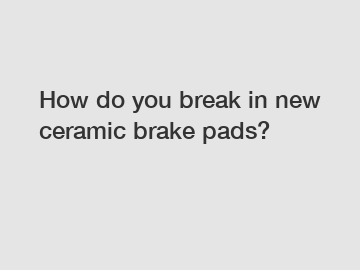How do you break in new ceramic brake pads?
Welcome to our blog, where we delve into the art of automobile maintenance and impart valuable knowledge to ensure a seamless driving experience. Today, we focus on a crucial aspect - breaking in new ceramic brake pads. As your trusted source, we will guide you through the process, highlighting the benefits, importance, and best practices involved. So, fasten your seatbelts and let's get started!
Section 1: Understanding Ceramic Brake Pads.
Before we delve into breaking in new ceramic brake pads, it is essential to understand the material we are dealing with. Ceramic brake pads are a popular choice among modern-day vehicles due to their exceptional braking performance, reduced dust levels, and extended lifespan. Composed of ceramic fibers, bonding agents, and friction modifiers, these pads provide optimal stopping power and consistent performance.

Section 2: The Importance of Breaking In Brake Pads.
Many vehicle owners overlook the significance of breaking in new ceramic brake pads. However, this crucial step in the installation process ensures effective contact between the pad and the rotor. By following the recommended break-in procedure, we maximize the pads' performance, prevent premature wear, and avoid potential noise issues.
Section 3: The Break-In Process.
Breaking in your new ceramic brake pads is a straightforward yet vital procedure. To ensure optimal results, adhere to the following steps:
1. Find an Open Area: Locate an empty road or a parking lot where you can safely perform several braking maneuvers.
2. Gradual Acceleration and Deceleration: Begin by gradually accelerating your vehicle to a moderate speed, around 30-40 mph. Once at this speed, gently engage the brakes to bring the car to a complete stop. Repeat this process several times, allowing 30 seconds of cooling time between each repetition.
3. Moderate Pressure: During the break-in period, apply moderate pressure to the brake pedal without fully engaging it. This allows for the transfer of an even layer of friction material onto the rotor's surface.
4. Controlled Speed Reduction: Once your new ceramic brake pads have undergone a few repeated cycles, it's time to test their performance. Drive at a safe speed and apply moderate pressure to the brake pedal, observing the pads' responsiveness. Ensure you do not exceed recommended speed limits during this process.
5. Gradual Cooling: After a few cycles of controlled speed reduction, it's important to cool down the brakes. Avoid prolonged braking or coming to an abrupt stop while the brakes are still hot. Allow your vehicle sufficient time to regain normal operating temperature by driving at a reduced speed.
Section 4: Benefits of Proper Break-In.
Following a correct break-in process holds several advantages. Firstly, it promotes a proper mating between the ceramic brake pads and the rotor, reducing the chance of noise and vibration. Secondly, it ensures optimal performance and longevity of your brake system, allowing for consistent stopping power in emergency situations. Lastly, a proper break-in also serves to dissipate any volatile compounds present on the friction surfaces, further improving braking efficiency.
Conclusion:
As conscientious vehicle owners, it is crucial that we acquaint ourselves with proper brake pad break-in techniques. By following the outlined steps, we can unleash the full potential of new ceramic brake pads, elevating our driving experience while ensuring safety and reliability.
Remember, a well-executed break-in procedure sets the foundation for a long and efficient brake system lifespan. So take the time to familiarize yourself with the process and enjoy the peace of mind that comes from knowing your brakes are operating at optimal levels. Stay safe, and happy driving!
DISCLAIMER: The information provided in this blog is for educational purposes only. Always refer to your vehicle's manufacturer guidelines and consult a professional mechanic for specific brake-related concerns.
If you want to learn more, please visit our website Semi-Metallic Brake Pad Supplier, Asian Vehicles Brake Pad Manufacturer, Bmw Oem Brake Pad Manufacturer.
181
0
0


Comments
All Comments (0)